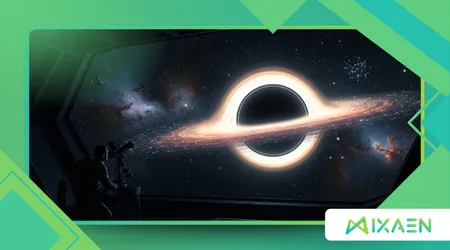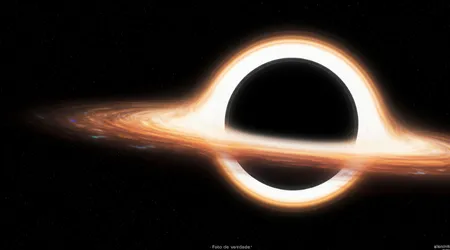What If Black Holes Are Actually Holograms?

What If Black Holes Are Actually Holograms? Imagine peering into the cosmos and questioning reality itself. This provocative idea challenges our grasp on space, time, and matter.
Anúncios
Scientists have long puzzled over black holes’ bizarre traits. Their immense gravity traps light, yet they might encode information on surfaces, not volumes.
Recent breakthroughs in quantum physics fuel this debate. Black holes, once seen as simple voids, now hint at deeper illusions.
Think about how a flat hologram creates three-dimensional depth. Could the universe operate similarly? This concept bridges general relativity and quantum mechanics, sparking endless curiosity.
As a seasoned columnist, I’ve tracked cosmic enigmas for years. The holographic principle isn’t new, but 2025’s discoveries add fresh twists. Gravitational wave detections surge, offering clues.
We stand at a threshold, rethinking black holes’ essence. Dive deeper with me into this mind-bending territory.
The Origins of the Holographic Idea
Gerard ‘t Hooft first floated the holographic principle in 1993. He suggested black hole information resides on event horizons. This countered volume-based entropy expectations.
Leonard Susskind expanded it in 1995. He argued the universe’s description fits lower-dimensional boundaries. Black holes became key testing grounds.
Juan Maldacena’s 1997 AdS/CFT correspondence revolutionized thinking. It links gravity in anti-de Sitter space to conformal field theory sans gravity. This duality supports holographic views.
Early motivations stemmed from black hole paradoxes. Hawking radiation implied information loss, violating quantum rules. Holography resolves this by surface storage.
Critics initially dismissed it as speculative. Yet string theory integrations bolstered credibility. Black holes’ entropy scales with area, not volume a holographic hallmark.
In everyday terms, picture a credit card hologram. Twist it, and a 3D image emerges from 2D. Similarly, our 3D world might project from 2D quantum data.
++ Could There Be Structures in the Universe Bigger Than the Observable Universe?
This analogy simplifies complex math. Real calculations involve intricate field theories. Yet it captures the essence: depth as illusion.
Skeptics point to observational gaps. No direct hologram tests exist yet. But theoretical consistency grows stronger yearly. Historical context matters too. Einstein’s relativity clashed with quantum mechanics. Holography aims to unify them via black holes.
Philosophers join the fray. Does this mean reality is simulated? Not necessarily, but it questions perception.

How Black Holes Fit Into This Picture
Black holes devour matter, yet preserve information holographically. Their horizons act like cosmic hard drives, encoding swallowed data.
Hawking’s 1974 radiation theory posed puzzles. Evaporating black holes seemed to erase info. Holography counters: data stays on surfaces.
What If Black Holes Are Actually Holograms? This flips traditional views. Instead of bottomless pits, they’re projections from boundaries.
Entropy calculations back this. Bekenstein-Hawking formula ties entropy to horizon area. It screams holographic nature. Quantum entanglement plays a role. Wormholes link distant points, mirroring holographic dualities.
Also read: What’s Causing the Great Void in Our Cosmic Neighborhood?
Visualize dropping a spaceship in. Classically, it’s lost. Holographically, info smears on horizons, retrievable in principle.
Another example: twin black holes merging. Gravitational waves carry data, aligning with surface encodings. Challenges arise near singularities. Gravity intensifies, but holography suggests no true interior.
AdS spaces model this best. Real universe is de Sitter-like, complicating applications. Yet approximations yield insights. Black hole microstates count via holography, matching entropy.
Firewalls debate emerged. Some propose energy barriers at horizons. Holography softens this.
Recent Developments in 2025
2025 brings exciting updates. Workshops like Giambiagi explore holography and black holes deeply. A July paper questions gravity concepts. It suggests cosmic loopholes imply universal illusions, tied to black holes.
August arXiv on holographic states in interiors advances models. BTZ black holes get new scrutiny. Popular Mechanics highlighted a loophole shattering gravity ideas. Black holes as evidence for holograms.
Quantum Zeitgeist reported reconstruction limits near horizons. Holography fails in extreme zones, per August 18 findings. Special issues in Physics of the Dark Universe cover holographic thermodynamics. BTZ black holes and Tsallis entropy featured.
Read more: The Axis of Evil in Space: Coincidence or Clue?
Indico events in June discussed microstates. Wormholes and shells model infinite families orthogonally.
These build on Maldacena’s work. Reference: Maldacena’s 1997 “The Large N limit of superconformal field theories and supergravity” in Adv.Theor.Math.Phys.2:231-252(1998).
ArXiv essays on emergent spacetime from quantum info. ‘t Hooft and Susskind cited anew. Observatories detect more mergers. Statistic: Over 300 black hole events via gravitational waves by mid-2025, per LIGO updates.
This data tests holographic predictions. Waveforms might reveal surface encodings subtly.
Implications and Challenges
What If Black Holes Are Actually Holograms? Universe-wide effects follow. Gravity emerges from quantum bits on boundaries.
Cosmology shifts. Big Bang as holographic projection? Horizons define early universe info. Quantum computing benefits. Holographic duals simulate gravity efficiently.
Challenges: reconciling with observations. No direct hologram proof yet. Critics argue over-simplification. Real spacetime isn’t purely AdS.
Firewall paradox lingers. AMPS paper suggested inconsistencies. Yet resolutions via complementarity. Observers see different realities.
Practical example: simulating mergers holographically. Predicts wave patterns accurately. Another: decoding Hawking radiation. Info emerges scrambled, but recoverable.
What if we harness this? Future tech might manipulate holographic data. Ethical angles surface. If reality’s projected, free will questions arise. Interdisciplinary links grow. Neuroscience meets holography in brain models.
A Deeper Dive into Quantum Entanglement
Entanglement underpins holography. Spooky action mirrors boundary connections. In black holes, ER=EPR conjecture links wormholes to entanglement.
Ryu-Takayanagi formula quantifies it. Minimal surfaces compute entanglement entropy. 2025 papers refine this. Negative entropy in black holes explored.
Do black holes store negative entropy? Oxford paper suggests yes, aiding holography. Analogy: like a mirror reflecting inverted images, but in info terms.
Rhetorical question: Isn’t it wild how quantum ties bind the cosmos? Experimental pushes: quantum simulators mimic AdS/CFT.
Table below compares key aspects.
| Aspect | Traditional Black Hole | Holographic Description |
|---|---|---|
| Information Storage | Volume-based, lost in singularity | Surface-encoded on horizon |
| Entropy Scaling | Proportional to volume (expected) | Proportional to area (observed) |
| Interior Reality | Physical spacetime collapse | Projection from boundary theory |
| Paradox Resolution | Information loss issue | Preserved via duality |
This table highlights shifts. More implications: multiverse ideas. Holography allows branching projections. Challenges in measurement. Horizon probes risky.
Conclusion
What If Black Holes Are Actually Holograms? This notion reshapes physics. From ‘t Hooft’s spark to 2025’s refinements, evidence mounts. We’ve explored origins, fits, developments, implications. Black holes as gateways to deeper truths.
Over 300 detections fuel tests. Holography unifies realms elegantly. Yet mysteries persist. Future observations might confirm or refute. As columnist, I urge curiosity. Cosmos holds surprises.
Reflect on this: our reality, projected? It humbles and excites. Ponder examples like merging holograms simulating collisions. Or everyday: phone screens projecting 3D illusions via apps.
The journey continues. Stay tuned for cosmic revelations. In 2025, with advancing tech, answers draw nearer. Embrace the wonder. Black holes might just be the ultimate illusionists.
Frequently Asked Questions
What is the holographic principle?
It proposes that the universe’s information is encoded on a lower-dimensional boundary, like a hologram.
How does this relate to black holes?
Black holes’ entropy scaling with area supports the idea that their “insides” are holographic projections.
Are there real experiments testing this?
While direct tests are hard, quantum simulations and gravitational wave data provide indirect evidence.
What if it’s true what changes?
It could unify quantum mechanics and gravity, revolutionizing physics and technology.
Is the universe really a hologram?
It’s a leading theory, but unproven. 2025 research advances understanding without final proof.
